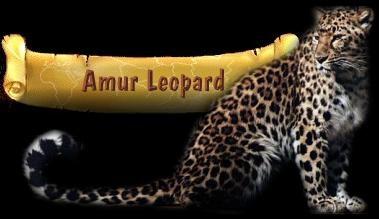

Amur Leopard - Page 1&2:
In The Wild | 3&4:
In Captivity | 5&6:
Subspecies Description |
7:
Weight & Length Figures | 8&9:
Conservation
Correcting genetic mistakes:
Genetic analysis has confirmed that early on in the development of the programme a leopard from another subspecies was accidentally introduced into the gene pool. Though the 'out breeding' of such complications is not impossible, it can easily take 10 generations (50 years) before mistakes of this type are eradicated, if indeed they ever are. It is only in recent times that the differences between captive and wild Amur leopards have been recognised. Any good captive breeding programme tries to conserve the animal in a state as close to original as is possible and the EEP aims to do just that. The endangered Chinese leopard:It is likely that the cross-breeding which occurred with the Amur leopard involved another subspecies living nearby; which one remains unknown. The video on this page shows Chinese leopards; these live in Northern China, just south of the Amur leopard. They are listed as endangered and only about 2,500 remain in the wild, with approximately 100 in captivity. There is also a photograph of a Chinese leopard. Of interest is that this cat only has three legs. Though, in captivity, he has no problems and can even jump as well as normal leopards, in the wild he would not have survived. |
Most of the images displayed in Tiger Territory's Amur leopard section were kindly supplied by the Feline Conservation Center in California. This organisation holds 3 of the top 10 Amur leopard males in the United States and 4 of the top 10 females. All of their leopards are purebred, though not all are recommended for use as breeding stock. Amur leopard breeding controls:This happens with very many threatened animal species; there are only so many times an animal can be bred from before its contribution to the gene pool threatens to become too high. To avoid inbreeding, controlled conservation programmes withdraw animals prior to this stage. Re-introduction schemes have been considered for the Amur leopard, however no plans for release can be put into action until better protection can be offered in the wild. There is even worse news. To produce enough Amur leopard stock for re-introduction would require the use of the hybrid cats; there are simply not enough purebred Amur leopards available. It remains to be seen whether or not Russian experts would accept this idea. |
|
Amur Leopard
- Page 1&2:
In The Wild | 3&4:
In Captivity | 5&6:
Subspecies Description
| Amur | Bali | Bengal | Caspian | Corbetts | Javan | Sumatran | South Chinese | Amur Leopard |
|
Photography
With Thanks To The Feline
Conservation Center. |